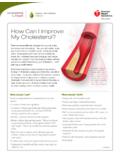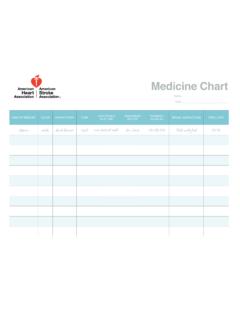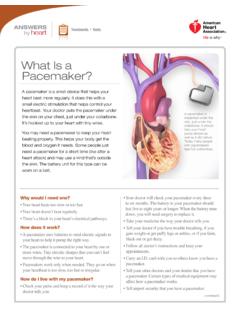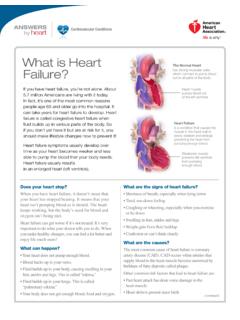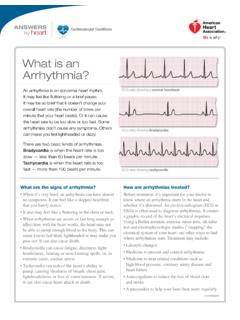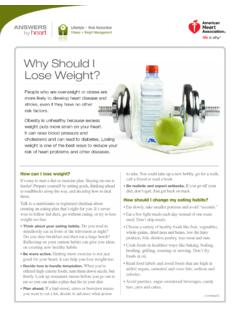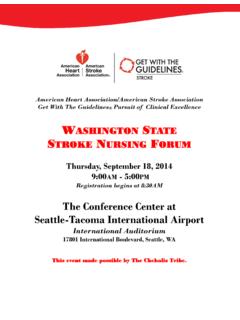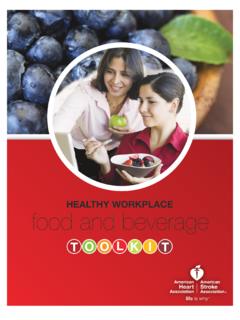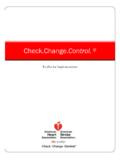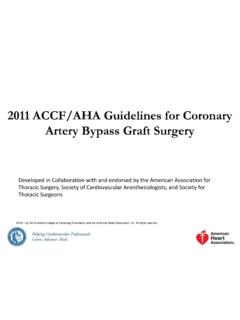Transcription of GET WITH THE GUIDELINES - American Heart Association
1 GET with THE GUIDELINESMANAGEMENT OF THE Heart FAILURE PATIENT Meg Treacy, DNP, ANP-CCardiac Nurse Practitioner/ Heart Failure Coordinator Englewood, CO Outline Heart failure basics Discuss evidence-based medical management of Heart failure Discuss, in particular, evidence-based beta-blocker therapy for left ventricular systolic dysfunction Review ACCF/AHA GUIDELINES on care transitionHEART FAILURE BASICSWhat is Heart failure (HF)? HF is a complex clinical syndrome(collection of symptoms) that results from any structural or functional impairment of ventricular filling or ejection of blood When the Heart is not able to maintain adequate cardiac output to perfuse organ systems adequately and meet the metabolic needs of the body Symptoms caused by systemic and/or pulmonary congestion due to low output Symptoms include: dyspnea, fatigue, poor exercise tolerance, orthopnea, PND, abdominal fullness, cough, frothy sputum, nocturia Physical exam findings.
2 Peripheral edema, ascites, lung rales/crackles, elevated JVP, S3 gallop, tachypnea, hepatomegaly, abdominal distention, Lab work and imaging: elevated BNP, NT pro-BNP, congestion on CXRWhat is cardiomyopathy? Cardiomyopathy = disease of Heart muscle A heterogeneous group of diseases of the myocardium associated with mechanical and/or electrical dysfunction that usually (but not invariably) exhibit inappropriate ventricular hypertrophy or dilatation and are due to a variety of causes that frequently are genetic. Cardiomyopathies either are confined to the Heart or are a part of generalized systemic disorders, often leading to cardiovascular death or progressive Heart failure-related disability.
3 Ischemic cardiomyopathy Most common cause of Heart failure Heart muscle damage from prior infarct (scar) or ischemia Non-ischemic cardiomyopathy Hypertensive, due to valve disease, lung disease (right sided), arrhythmia (tachycardia-induced), toxic (ETOH, cocaine), viral, HIV, sarcoid, due to congenital anomaly, idiopathic dilated, myocarditis, chemotherapy-induced, restrictive, hypertrophic, stress-induced ( Takotsubo), pregnancy/post-partumTypes of Heart failure Systolic Heart failure Signs of clinical Heart failure + left ventricular ejection fraction (LVEF) less than 40% Diastolic Heart failure Signs of clinical Heart failure + LVEF is greater than 40% Right Heart failure Isolated right-sided dysfunction, left Heart systolic function types of Heart failure are treated differently!
4 HFrEFHFpEFBorderline HFpEFImprovedHFpEFDefinition LV systolic dysfunctionLV systolic functionpreserved, a filling problemCharacteristics, treatment patterns, & outcomes appear similar to those of patients with HFpEFPatients who previouslyhad EF <40%LVEF<40%>50%41-49%>40%TherapiesBB + ACEi/ARB +aldosterone antagonist if EF is less than 35%BP,HR control, treat symptoms with diuresisBP,HR control, treat symptoms with diuresisTypicallyremain on BB and ACEi/ARBMEDICAL MANAGEMENT OF Heart FAILURE 2013 ACCF/AHA Guideline for the Management of Heart FailureClassification of Recommendationand Level of EvidenceMANAGEMENT OF SYSTOLIC Heart FAILURES ystolic Heart failure Also referred to as HF with reduced ejection fraction (HFrEF)
5 Clinical diagnosis of Heart failure + LVEF less than or equal to 40% Commonly due to coronary artery disease, often with history of prior MI Other common causes Toxic cardiomyopathy 2/2 ETOH use, cocaine, chemo Viral/myocarditis -> dilated cardiomyopathy Stress cardiomyopathy (physical or emotional stressor) Tachycardia-induced cardiomyopathy Only in HFrEF patients have medical therapies been proven to be efficacious Treatment of systolic Heart failure Evidence-based beta-blocker Class I: Use of 1 of the 3 beta blockers proven to reduce mortality ( , bisoprolol, carvedilol, and sustained-release metoprololsuccinate) is recommended for all patients with current or prior symptoms of HFrEF, unless contraindicated, to reduce morbidity and mortality(Level of Evidence: A) ACE inhibitor or angiotensin receptor blocker Class I: ACE inhibitors are recommended in patients with HFrEF and current or prior symptoms, unless contraindicated, to reduce morbidity and mortality (Level of Evidence: A) Class I.
6 ARBs are recommended in patients with HFrEF with current or prior symptoms who are ACE inhibitor intolerant, unless contraindicated, to reduce morbidity and mortality (Level of Evidence: A)Treatment of systolic Heart failure Aldosterone antagonist for LVEF <35% Class I: Aldosterone receptor antagonists (or mineralocorticoid receptor antagonists) are recommended in patients with NYHA class II IV HF and who have LVEF of 35% or less, unless contraindicated, to reduce morbidity and mortality. Patients with NYHA class II HF should have a history of prior cardiovascular hospitalization or elevated plasma natriuretic peptide levels to be considered for aldosterone receptor antagonists.
7 Creatinine should be mg/dL or less in men or mg/dL or less in women (or estimated GFR >30), and potassium should be less than mEq/L. Careful monitoring of potassium, renal function, and diuretic dosing should be performed at initiation and closely followed thereafter to minimize risk of hyperkalemia and renal insufficiency (Level of Evidence: A) Class I: Aldosterone receptor antagonists are recommended to reduce morbidity and mortality following an acute MI in patients who have LVEF of 40% or less who develop symptoms of HF or who have a history of diabetes mellitus, unless contraindicated (Level of Evidence: B)Why these medications?
8 BETA-BLOCKERS IN SYSTOLIC Heart FAILUREE vidence-based beta-blockersInitial daily doseMax dose Mean dose achievedin clinical mg daily10 mg mg/dayCarvedilol (Coreg) mg BID50 mg BID37mg/dayCarvedilol CR10 mg daily80 mg dailyn/aMetoprololsuccinate (Toprol XL) mg-25mg daily200 mg daily159 mg/dayWhat s tartrate (Lopressor)! Which is the BID version of metoprolol Why Toprol XL but not Lopressor? MERIT-HF trial (1999) Purpose was to determine if metoprolol succinate decreases mortality in patients with symptomatic HF with reduced ejection fraction Study demonstrated a 34% reduction in all cause mortality with treatment with metoprolol succinate (versus placebo) and led to its approval by the FDA metoprolol tartrate was NOT approval Mortality benefit consistent with that seen with carvedilol in CAPRICORN and bisoprolol in CIBIS-IIWhy Toprol XL but not Lopressor?
9 COMET trial (2003) Purpose was to compare the effects of carvedilol and metoprolol tartrate on morbidity and mortality in patients with mild to severe chronic heat failure and reduced LV ejection fraction The only major direct comparison study of beta-blockers and demonstrated a 17% reduced in relative risk of death with treatment with carvedilol over metoprolol tartrate (short acting metoprolol) in patients with NYHA class II-IV and LVEF <35% Comment: metoprolol succinate (long acting, Toprol XL) was not commercially available when this trial startedAdditional comments about Metoprolol tartrate is dosed BID but duration is variable and dose related 50% reduction in maximum Heart rate after single doses of 20, 50, and 100 mg occurred at , 5, and hours, No head-to-head comparison has been done between carvedilol and metoprolol succinate MADIT-CRT (2009)
10 Study on benefit from cardiac resynchronization therapy Recent retrospective analysis demonstrated a 30% reduction in hospitalized for Heart failure or death in patients treated with carvedilol over metoprolol MANAGEMENT OF DIASTOLIC Heart FAILURED iastolic Heart failure Also referred to as HF with preserved ejection fraction (HFpEF) Clinical diagnosis of Heart failure + LVEF greater than or equal to 50% Commonly due to hypertension Patients often are older and female Highprevalence of obesity, diabetes, atrial fibrillation Treatment of diastolic Heart failure We don t know!
